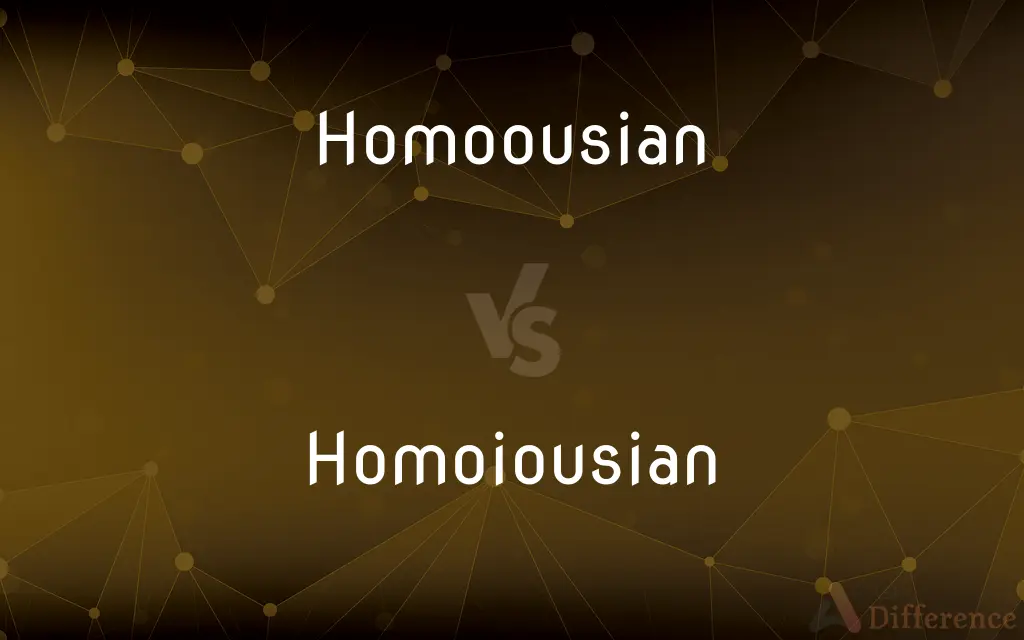Homoousian vs. Homoiousian — What's the Difference?
Edited by Tayyaba Rehman — By Maham Liaqat — Updated on April 7, 2024
Homoousian doctrine posits that Jesus Christ and God share the same substance, while Homoiousian suggests a similar but not identical essence.

Difference Between Homoousian and Homoiousian
Table of Contents
ADVERTISEMENT
Key Differences
The term Homoousian is central to Christian theology, indicating that Jesus Christ is of the same substance as God the Father. This concept was pivotal in the development of orthodox Christian doctrine, emphasizing the unity and coequality of the Father and the Son. On the other hand, Homoiousian represents a slight yet significant theological divergence, suggesting that Jesus Christ is of a substance similar to, but not exactly the same as, God the Father. This nuanced difference underscores a distinct theological stance regarding the nature of Christ and his relationship to God.
The Homoousian viewpoint was solidified at the First Council of Nicaea in 325 AD, becoming a cornerstone of Nicene Christianity. It articulates a strong stance on the divinity of Jesus, asserting that the Son is not a created being but coeternal with the Father. Whereas, the Homoiousian perspective gained traction among those who sought a middle ground between the stark Arian assertion of Christ's created nature and the Nicene affirmation of his consubstantiality with the Father. It aimed to maintain a form of monotheism without compromising the distinctiveness of the Father and the Son.
In terms of theological implications, Homoousians argue that salvation and redemption are possible only because Jesus is fully divine, sharing the same essence as God. This ensures that Jesus' acts have infinite value, capable of redeeming humanity from sin. Conversely, Homoiousians, while affirming the similarity of essence between Jesus and God, introduce a subtle distinction that can imply a lesser degree of divinity. This has implications for understanding the mechanism of salvation and the nature of Christ's atonement.
The debate between Homoousian and Homoiousian thought reflects broader concerns within Christian theology about the relationship between unity and diversity within the Godhead. Homoousianism underlines a unity of essence that supports the doctrine of the Trinity, where Father, Son, and Holy Spirit are distinct persons sharing a single divine essence. Meanwhile, Homoiousianism allows for a greater emphasis on the economic Trinity, the differentiated roles within God’s singular plan of salvation, suggesting a more nuanced interpretation of the Trinity’s unity.
Historically, the conflict between these two positions contributed to the Arian controversy, which was one of the early church’s most significant theological disputes. This controversy not only shaped the development of early Christian doctrine but also had profound effects on the political and social landscape of the Roman Empire. While Homoousianism ultimately prevailed in defining orthodox Christian belief, the Homoiousian perspective remained influential in various sects, reflecting the ongoing struggle to articulate the mystery of the Trinity.
ADVERTISEMENT
Comparison Chart
Definition
Of the same substance
Of similar substance
Originated
First Council of Nicaea, 325 AD
Post-Nicaea, as a middle ground
Theological Implication
Jesus is fully divine, equal to the Father
Jesus is divine but not identically to the Father
Impact on Doctrine
Solidified the doctrine of Trinity
Sought a compromise in the Arian controversy
Salvation Implications
Salvation possible through Jesus' divine nature
Implies a nuanced view of Jesus' divinity
Compare with Definitions
Homoousian
Argues against Jesus being a created being.
Homoousian belief contradicts the idea that Jesus was created by the Father.
Homoiousian
Pertaining to being of a similar substance to God.
Homoiousian thought proposes a likeness rather than identity in substance between Jesus and God.
Homoousian
Pertaining to being of the same substance as God.
The Homoousian doctrine affirms that Jesus and the Father are consubstantial.
Homoiousian
Emerged as a compromise in theological debates.
Homoiousians sought middle ground during the Arian controversy.
Homoousian
Central to Nicene Christianity.
Homoousian theology was crucial in defining orthodox belief against Arianism.
Homoiousian
Lessens the degree of Jesus' divinity.
By describing Jesus’ essence as similar, Homoiousianism subtly distances Jesus from full divinity.
Homoousian
Emphasizes the divinity of Jesus.
Homoousianism asserts that Jesus' divinity is essential for the concept of redemption.
Homoiousian
Highlights the distinctiveness of the Trinity’s persons.
Homoiousianism emphasizes the uniqueness of the Father, Son, and Holy Spirit.
Homoousian
Supports the unity within the Trinity.
Through Homoousianism, the Church upheld the coequality of the Trinity's persons.
Homoiousian
Facilitates a nuanced understanding of salvation.
Homoiousian perspectives contribute to diverse interpretations of atonement and redemption.
Homoousian
A Christian supporting the Council of Nicaea's Trinitarian doctrine that Jesus, as Son of God, is consubstantial with God the Father.
Homoiousian
Homoiousios (Greek: ὁμοιούσιος from ὅμοιος, hómoios, "similar" and οὐσία, ousía, "essence, being") is a Christian theological term, coined in the 4th century by a distinctive group of Christian theologians who held the belief that God the Son was of a similar, but not identical, essence (or substance) with God the Father. Homoiousianism arose as an attempt to reconcile two opposite teachings, homoousianism and homoianism.
Homoousian
Having the same essence or substance, especially with reference to the first and second persons of the Trinity.
Homoiousian
An adherent of the Christian doctrine, formulated in the fourth century AD, that Jesus the Son and God the Father are of similar but not of the same substance.
Homoousian
(historical) One of those, in the 4th century, who accepted the Nicene Creed and maintained that the Son had the same essence or substance with the Father.
Homoiousian
Having a similar but not identical essence, especially with reference to the first and second persons of the Trinity
Homoousian
One of those, in the 4th century, who accepted the Nicene creed, and maintained that the Son had the same essence or substance with the Father; - opposed to homoiousian.
Homoiousian
(historical) One of the Semi-Arians of the 4th century who held that the Son was of like, but not the same, essence or substance with the Father.
Homoousian
Of or pertaining to the Homoousians, or to the doctrines they held.
Homoiousian
One of the semi-Arians of the 4th century, who held that the Son was of like, but not the same, essence or substance with the Father; - opposed to homoousian.
Homoiousian
Of or pertaining to Homoiousians, or their belief.
Common Curiosities
What is Homoousian?
Homoousian theology asserts that Jesus Christ and God the Father are of the same substance, emphasizing their complete divinity and unity.
Can Homoiousianism be considered orthodox?
Historically, it was not adopted by mainstream Christianity and is viewed as a compromise position in the Arian controversy, outside of orthodox Nicene Christianity.
How does Homoiousian differ from Arianism?
While Arianism outright denies the divinity of Christ, describing Him as a created being, Homoiousianism affirms Christ's divinity but as similar rather than identical to God’s.
What does Homoiousian mean?
Homoiousian refers to the belief that Jesus Christ is of a substance similar to, but not identical with, that of God the Father, suggesting a form of similarity in divinity.
Why is the Homoousian doctrine important?
It is foundational for the orthodox Christian understanding of the Trinity, affirming the coeternal, consubstantial nature of Jesus with God, crucial for the doctrine of salvation.
How do Homoousian and Homoiousian views interpret the Trinity?
Homoousianism emphasizes a unity of essence among the Father, Son, and Holy Spirit, supporting the doctrine of the Trinity as three persons of the same substance. Homoiousianism, while not denying the Trinity, suggests a degree of distinction in essence that could imply a more nuanced relationship among the Trinity's persons.
How did the First Council of Nicaea impact the Homoousian doctrine?
The First Council of Nicaea in 325 AD decisively endorsed the Homoousian doctrine, establishing it as a central tenet of Christian orthodoxy to combat Arianism, thereby affirming the full divinity of Jesus Christ as being of the same substance as the Father.
Is Homoiousianism still present in modern theology?
While not a dominant strain within mainstream Christian theology, the Homoiousian perspective influences some contemporary theological discussions, particularly those exploring the nature of Christ's divinity and the Trinity's unity and diversity.
What role did political and ecclesiastical authorities play in these debates?
Political and ecclesiastical authorities, particularly Roman Emperors and church councils, played significant roles in these debates, often influencing the acceptance or condemnation of these positions based on broader socio-political considerations and the need for church unity.
Were there any compromises between Homoousian and Homoiousian positions?
Throughout the early Christian debates, several attempts were made to find a theological middle ground, but these were often short-lived or deemed unsatisfactory by both sides. The Homoousian position eventually prevailed in orthodox Christianity, with Homoiousianism and other views considered heretical.
How does the debate between Homoousian and Homoiousian reflect broader themes in Christian theology?
The debate touches on fundamental theological questions about the nature of God, the incarnation, and salvation, reflecting broader themes in Christian theology such as the balance between unity and diversity, the intersection of divine transcendence and immanence, and the relationship between doctrine and piety.
How do these theological differences affect the understanding of Jesus' nature?
Homoousianism affirms the full deity and humanity of Jesus Christ, making no distinction between His essence and that of God the Father, thus ensuring the efficacy of salvation. Homoiousianism, by suggesting a similarity rather than identity, could imply a nuanced interpretation of Jesus' nature and its impact on the atonement.
What implications do these doctrines have for Christian worship and practice?
These doctrines deeply influence Christian liturgy, worship, and the understanding of sacraments, particularly in affirming the presence of Christ and the work of the Holy Spirit, reflecting the theological convictions about the nature of God as expressed in the Trinity.
Are there scriptural bases for Homoousian and Homoiousian positions?
Proponents of both positions have sought to justify their views through scripture, with Homoousians pointing to passages affirming the divinity and pre-existence of Christ, and Homoiousians emphasizing texts that they believe indicate a distinction between the Father and the Son. The interpretation of these passages remains a central aspect of the debate.
What were the main arguments against Homoiousianism?
Critics of Homoiousianism argued that it introduced ambiguity into the nature of Christ's divinity, potentially compromising the unity of God and diluting the efficacy of Jesus' redemptive work by not affirming a full and unequivocal divinity identical to that of the Father.
Share Your Discovery

Previous Comparison
Infinity vs. Finity
Next Comparison
Underwear vs. UnderpantsAuthor Spotlight
Written by
Maham LiaqatEdited by
Tayyaba RehmanTayyaba Rehman is a distinguished writer, currently serving as a primary contributor to askdifference.com. As a researcher in semantics and etymology, Tayyaba's passion for the complexity of languages and their distinctions has found a perfect home on the platform. Tayyaba delves into the intricacies of language, distinguishing between commonly confused words and phrases, thereby providing clarity for readers worldwide.














































